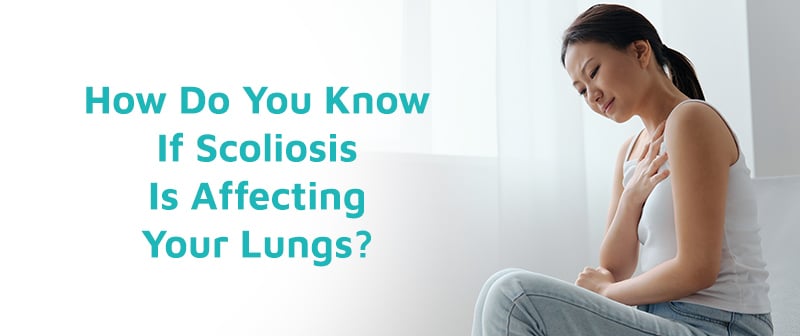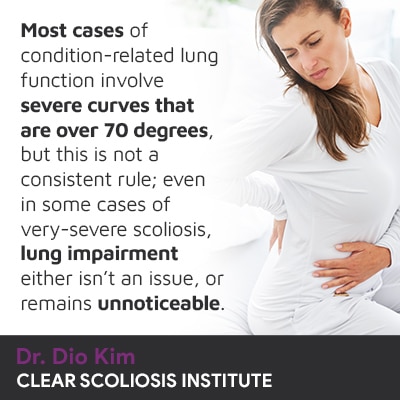
Although scoliosis is a spinal condition, its effects can be felt throughout the body. Not only does the spine facilitate healthy posture, the ability to stand upright, and engage in a wide range of flexible motions, it also works with the brain to form the central nervous system (CNS). If scoliosis is severe and/or is left untreated, it can progress to the point of causing related complications, such as lung impairment.
While lung impairment isn’t a common symptom of scoliosis, factors such as patient age, curvature location, condition type and severity help shape condition effects and potential complications. If scoliosis is affecting the lungs, the ability to inhale/exhale deeply can be impacted.
Scoliosis can affect the body in a number of ways, but every case is different, so let’s start with how conditions are diagnosed and classified.
Scoliosis isn’t the only spinal condition that involves a loss of healthy spinal curves, which is why a number of parameters have to be met to reach a scoliosis diagnosis.
Scoliosis isn’t just the development of an unnatural lateral spinal curve, a scoliotic spine also has to have a rotational component, meaning it twists, in addition to bending unnaturally.
It’s the condition’s rotational element that makes scoliosis a complex 3-dimensional condition.
Part of diagnosing scoliosis involves comprehensively assessing and further classifying conditions based on important patient/condition factors that can vary from patient to patient.
Classifying scoliosis is important because the condition’s classification points are what effective treatment plans are shaped around, and each factor impacts a patient’s life with scoliosis in a different way.
The big effects that are shaped by patient age are pain and progression.
As a progressive condition, scoliosis is virtually guaranteed to get worse over time, and this means that the unnatural spinal curve is getting larger, and as this happens, the condition’s uneven forces, and their effects, are also increasing over time.
The longer a condition is left untreated, and the more severe it is, the more likely further progression is, and the more noticeable its effects are going to be, as well as the potential for developing related complications.
The main trigger for scoliosis progression is growth, so in young patients who have not yet reached skeletal maturity, rapid-phase progression can be an issue, so this is factored into treatment plans, whereas adults who are no longer growing don’t require as much close monitoring when it comes to progression.
Patient age also helps shape how painful a condition is likely to be because scoliosis doesn’t become a compressive condition until adulthood is reached.
Growing spines are experiencing a continuous lengthening motion, and this counteracts the compression caused by scoliosis, and compression of the spine, and its surrounding muscles and nerves, is the main cause of scoliosis pain.
Now, there are, of course, other factors such as condition severity and the amount of rotation that also factor into how painful a patient’s scoliosis is, but patient age is significant.
Curvature location is important because while the entire spine is affected by scoliosis, the location of the curvature tells me where to concentrate certain treatment efforts, and scoliosis can develop in any of the spine’s main sections, or in more than one as a combined scoliosis: thoracolumbar scoliosis, for example, that involves the lower thoracic spine and the upper lumbar spine.
The spine’s main sections include the cervical spine (neck), thoracic spine (middle/upper back), and lumbar spine (lower back).
Certain symptoms, condition effects, and potential complications are more closely associated with particular curvature locations.
For example, scoliosis in the lumbar spine can lead to complications such as developing sciatic nerve pain; the sciatic nerve starts in the lower back, so if an unnatural curvature of the lumbar spine is exposing the sciatic nerve to uneven pressure, it can cause sciatic nerve pain to develop as a related complication.
When it comes to thoracic scoliosis, the most common location, this is closely associated with the development of a rib arch, which is most likely to result in lung impairment as the disrupted natural position of the rib cage can encroach on the space used by the respiratory system.
While the effects of scoliosis can be felt throughout the body, in most cases, the area of the body located closest to the affected spinal section is going to experience the majority of its direct effects, as is the case with lumbar scoliosis and sciatica and thoracic and/or thoracolumbar scoliosis, a rib arch, and potential lung impairment.
Condition type is determined by causation, and interestingly enough, in the most-prevalent form of scoliosis, we don’t fully understand what causes it.
Idiopathic scoliosis is the most common type of scoliosis to affect children and adults, and the idiopathic classification means we don’t fully understand what triggers the condition’s initial onset, but we do know how to treat it, and we do know that growth triggers its progression.
Adolescent idiopathic scoliosis (AIS), diagnosed between the ages of 10 and 18, is the most-prevalent form of scoliosis overall.
Idiopathic scoliosis accounts for approximately 80 percent of known scoliosis cases, with the remaining 20 percent consisting of types with known causes: neuromuscular scoliosis, degenerative scoliosis, and congenital scoliosis.
Idiopathic scoliosis is considered typical, and in typical cases of scoliosis, the scoliotic curve bends to the right, away from the heart, but in atypical cases such as neuromuscular and/or congenital scoliosis, the curve can bend to the left, towards the heart, and these types are also more likely to develop complications such as lung impairment because there is an underlying pathology.
Condition severity is determined by a measurement known as Cobb angle, which is determined during X-ray.
A patient’s Cobb angle tells me how tilted the vertebrae are at the curve’s apex, which tells me how far out of alignment a patient’s spine is, and classifies conditions in terms of severity:
The condition’s severity levels are also its progressive line, so even if a patient is diagnosed with mild scoliosis, if left untreated, it can become moderate or severe, and the more a condition progresses, the more complex it is to treat.
As a scoliotic curve increases in size, it gets more rigid, making it less responsive to chiropractic-centered treatment, and the supportive muscles surrounding the spine can also become unbalanced: muscles on one side can become stretched and loose from overuse, while muscles on the opposite side can become weak and risk atrophy from underuse.

While each case of scoliosis is unique, the more severe it is, the more noticeable its effects are likely to be.
In mild cases, particularly in children/adolescents for whom the condition is not yet compressive, functional deficits are rare, and even the condition’s early signs can be subtle and difficult to detect.
In children and adolescents, the main symptom of scoliosis is postural deviation:
In adults, the main symptom is pain, and the more severe, and the more rotation there is, the more painful it’s likely to be.
When it comes to scoliosis and lung function, lung impairment is not a common symptom, particularly in mild and moderate cases, and/or in young patients; however, when severe, and especially in cases of thoracic scoliosis that are left untreated, the level of postural deviation can disrupt the natural position of the rib cage to the point that it affects lung function.

An important factor affecting how noticeable changes to lung function are going to be is the level of demand a patient is placing on their respiratory system, as well as patient age.
An average person placing average demands are less likely to notice changes to lung function than, say, a professional athlete who is placing higher-than-average demands on their respiratory systems; in these types of cases, noticeable changes can include shallow breathing, feeling unable to catch a breath, and/or difficulties inhaling/exhaling deeply.
In general, even in some cases of severe scoliosis, lung deficiencies aren’t going to be overly noticeable during regular day-to-day activities, but during times of extreme physical exertion, particularly in older patients, those extra demands placed on lung tissue and volume can magnify any disruptions to lung function.
When it comes to answering questions regarding scoliosis symptoms and potential complications, there are no clear-cut answers.
As a complex structural spinal condition that can range so widely in severity and with multiple condition types, symptoms one patient experiences aren’t always indicative of how other patients will be affected.
Patients who are most likely to experience a noticeable disruption to lung function are older patients, those who regularly participate in intense activities/sports, and/or have severe thoracic or thoracolumbar scoliosis.
While there are tests that can measure a person’s lung-expiratory volume and assess pulmonary function, such as a spirometry and/or a plethysmography test, they are not always readily accessible, and the most obvious way of knowing whether or not scoliosis is affecting your lungs is in how they perform during exercise; if you don’t notice any changes, either scoliosis isn’t causing any related lung impairment, treatment has been successful, or the demands being placed on the respiratory system aren’t excessive.
The best way to minimize the potential effects of scoliosis, lung impairment included, is to commit to a proactive conservative chiropractic-centered treatment plan.
While there are no treatment guarantees, as a CLEAR-certified scoliosis chiropractor, I believe in starting treatment immediately following a diagnosis, when the chances of success are highest, and proactively working towards preventing related complications is far more effective than trying to reverse them in the future.

CLEAR provides a unique and innovative way of understanding scoliosis. Sign up to receive facts and information you won’t find anywhere else.
